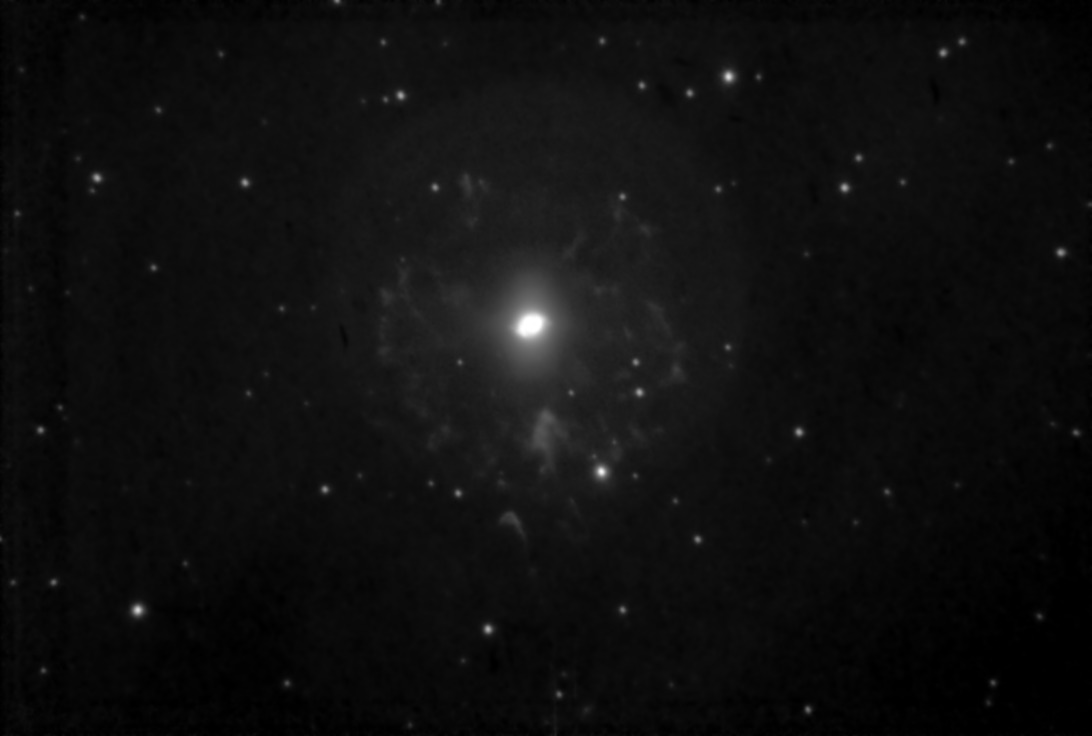NGC 6543
Cat's Eye Nebula

NGC 6543
Cat's Eye Nebula: The Cat's Eye nebula is approximately 3,500 light-years away, in the constellation Draco. It is one of the most complex nebulae known, leading to speculation that it might be the result of emissions from a binary central star. It falls nearly exactly in the direction of the North Ecliptic Pole, perpinducular to the plane of the solar system. The nebula is estimated to be approximately 1000 years old, based on measurements of its angular expansion. It was discovered by William Herchel in 1786 and was the first planetary nebula to be studied spectroscopically, by William Huggins in 1864. (http://en.wikipedia.org/wiki/NGC_6543)
NGC: 6543
Right Ascension: 17h 58.6m
Declination: 66° 38'
Apparent Magnitude: 9.8
Date: June 2009
Equipment:
Telescope: Meade 16" Schmidt Cassegrain with f6.3 reducer
Camera: SBIG ST-10XE
Guiding: Meade 5" refractor/DSI Pro/PHD
Exposure: Ha = 12x6 min subframes
Processing Notes: Data acquisition and reduction in CCDSoft. 12x6 minute exposures. Alignment was done in CCDStack, as CCDSoft did not get all the images. Sigma Beta was used to combine, and then an asin import to photoshop for final stretching and smoothing.
Scale: 1.01
Links to images of this object on other sites:
http://antwrp.gsfc.nasa.gov/apod/ap050924.html
http://www.seds.org/messier/xtra/ngc/n6543.html
Additional Comments: These subs were taken during an "overhead" drift alignment session. For these exposures, the Declination autoguiding was turned OFF, and the wedge was adjusted (East-West) until the drift was negligible. The first few subs showed definitely elongated stars, but by the end of the session (and lots of tiny tweaks to the wedge), the stars were nice and round and it looked like less than one pixel drift (at least on the guide scope) during the 6 minute exposures. Next time I would like to try 15 minute exposures and see if the alignment holds up.
A planetary nebula occurs when a sun-like star is reaching the end of its life. Typically, the star will have a core made of carbon, surrounded by a shell of helium (in the process of fusing into carbon), and outer layers of mostly Hydrogen. The fusing Helium will shrink and heat the core, attempting to fuse the carbon into heavier elements, but the temperature and pressure will never be great enough in a star of this (relatively low) mass to fuse the carbon. As a result, this very hot carbon core and helium shell drive off the outer layers of hydrogen. As these outer layers are driven off by the intense heat of the core, they form what is called a planetary nebula, that is visible as a shell of glowing gas surrounding a very hot central star. (Note that the term "planetary" has nothing to do with planets - they are called planetary because in early telescopes they appeared to be tiny fuzzy disks that reminded observers of planets!) Because the details of this shedding process can vary significantly from star to star, all planetary nebulae are unique, and many show multiple shells, as different layers are shed over a period of time. Eventually, the shell will dissipate and the hot core, now called a white dwarf, will remain. A white dwarf can have as much mass as the Sun, but compressed into a sphere the size of the Earth.
Views: 10508
 This work is licensed under a Creative Commons Attribution-NonCommercial-ShareAlike 4.0 International License.
This work is licensed under a Creative Commons Attribution-NonCommercial-ShareAlike 4.0 International License.

